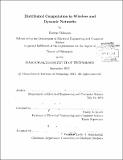| dc.contributor.advisor | Nancy A. Lynch. | en_US |
| dc.contributor.author | Oshman, Rotei | en_US |
| dc.contributor.other | Massachusetts Institute of Technology. Department of Electrical Engineering and Computer Science. | en_US |
| dc.date.accessioned | 2013-04-12T19:25:40Z | |
| dc.date.available | 2013-04-12T19:25:40Z | |
| dc.date.copyright | 2012 | en_US |
| dc.date.issued | 2012 | en_US |
| dc.identifier.uri | http://hdl.handle.net/1721.1/78456 | |
| dc.description | Thesis (Ph. D.)--Massachusetts Institute of Technology, Dept. of Electrical Engineering and Computer Science, 2012. | en_US |
| dc.description | Cataloged from PDF version of thesis. | en_US |
| dc.description | Includes bibliographical references (p. 211-221) and index. | en_US |
| dc.description.abstract | Today's wireless networks tend to be centralized: they are organized around a fixed central backbone such as a network of cellular towers or wireless access points. However, as mobile computing devices continue to shrink in size and in cost, we are reaching the point where large-scale ad-hoc wireless networks, composed of swarms of cheap devices or sensors, are becoming feasible. In this thesis we study the theoretical computation power of such networks, and ask what tasks are they capable of carrying out. how long does solving particular tasks take. and what is the effect of the unpredictable network topology on the network's computation power. In the first part of the thesis we introduce an abstract model for dynamic networks. In contrast to much of the literature on mobile and ad-hoc networks, our model makes fairly minimalistic assumptions; it allows the network topology to change arbitrarily from round to round, as long as in each round the communication graph is connected. We show that even in this weak model, global computation is still possible, and any function of the nodes' initial inputs can be computed efficiently. Also, using tools from the field of epistemic logic, we analyze information flow in dynamic networks, and study the time required to achieve various notions of coordination. In the second part of the thesis we restrict attention to static networks, which retain an important feature of wireless networks: they are potentially (symmetric. We show that in this setting. classical data aggregation tasks become much harder. and we develop both upper and lower bounds on computing various classes of functions. Our main tool in this part of the thesis is communication complexity: we use existing lower bounds in two-player communication complexity, and also introduce a new problem, task allocation, and study its communication complexity in the two-player and multi-player settings. | en_US |
| dc.description.statementofresponsibility | by Rotei Oshman. | en_US |
| dc.format.extent | 221 p. | en_US |
| dc.language.iso | eng | en_US |
| dc.publisher | Massachusetts Institute of Technology | en_US |
| dc.rights | M.I.T. theses are protected by
copyright. They may be viewed from this source for any purpose, but
reproduction or distribution in any format is prohibited without written
permission. See provided URL for inquiries about permission. | en_US |
| dc.rights.uri | http://dspace.mit.edu/handle/1721.1/7582 | en_US |
| dc.subject | Electrical Engineering and Computer Science. | en_US |
| dc.title | Distributed computation in wireless and dynamic networks | en_US |
| dc.type | Thesis | en_US |
| dc.description.degree | Ph.D. | en_US |
| dc.contributor.department | Massachusetts Institute of Technology. Department of Electrical Engineering and Computer Science | |
| dc.identifier.oclc | 832726539 | en_US |
